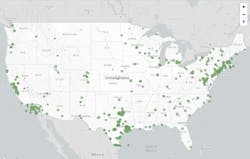If you’re wondering why interest in microgrids is growing at a rapid clip, look no further than a new report “Billion Dollar Losses, Trillion Dollar Threats: The Cost of Climate Change.”
Over the last five years, these events have cost the US $765 billion and led to 4,500 deaths, and since 1980 losses have totaled $2.2 trillion, according to the report.
“Climate change is no longer just an environmental issue or health issue or social justice issue,” said Bob Keefe, E2 executive director. “It’s all those things. But it’s also now a daunting economic issue, and it’s hitting every American in the pocketbook, no matter where they live, what they do or how they vote.”
In a sign that the problem is worsening, the report notes that the losses over the last five years were eight times greater than in the 1980s. From 2017-2021, America experienced its four most expensive wildfires, two of its three most expensive hurricanes, and its most expensive winter storm. (The report does not include the recent Hurricane Ian, which pummeled Florida in September.)
Power outages follow disasters
In some cases, one disaster precipitates the next. The California wildfires offer an example.
“Utilities across California have started to de-energize power lines (controlled grid outages to shut off electricity through transmission lines in specific areas) to prevent wildfires, which itself has likely caused billions of dollars more in economic impacts from business interruptions and poses a risk to many populations, such as those dependent on electricity to power medical equipment,” the report said.
Because disasters often lead to power outages and microgrids avert outages, there is a (sad) adage among microgrid insiders, “To track microgrid growth, follow the carnage.” Below we compare the report’s disaster map with a microgrid map by the US Department of Energy. The adage appears to largely hold true, particularly in two of the biggest disaster states in the lower 48, California and Texas, which clock some of the greatest microgrid activity.
Highest risk counties
The report drills further down to the county level and includes data from FEMA on the top counties at highest risk for future losses from climate and weather. Texas dominates the list with six of counties: Harris, Galveston, Fort Bend, Colin, Montgomery and Brazoria. Other counties in the top 10 are Ocean, New Jersey; Santa Barbara, California; Orleans, Louisiana; and Palm Beach, Florida. (The report also lists risk by congressional district, which may be instructive for lawmakers considering microgrid legislation.)
But the geographic assessment doesn’t tell the whole story because it doesn’t account for economic disparities in each area, according to the report.
“This analysis largely discusses total economic impacts of these disasters, but this metric is somewhat limited as well: It may be much harder for a low-income household to recover from the flooding of a less expensive house than for a wealthier household to recover from damage to a more expensive house, even if the total monetary damage of the latter is larger,” the report said. “Rapid and sustained investment in climate mitigation and adaptation can help avert the worst of these impacts and protect those communities who are disproportionately at risk while providing opportunities in the form of jobs and economic growth.”
Solution lies with energy
While climate change is not the sole driver of natural disasters, it contributes to their frequency and severity, the report said, and calls for decarbonization and more renewable energy to avert the worst impacts. Such efforts can realize up to $3 trillion in GDP gains by 2050, according to the report.
The report cites the Inflation Reduction Act, signed into law by President Biden in August, as a step in the right direction because it offers $370 billion for clean energy investments, tax credits and programs, including funding targeted at underresourced and low-income communities.
The full report is available here.
Track news about microgrids. Subscribe to the free Microgrid Knowledge Newsletter.
About the Author
Elisa Wood
Editor-in-Chief
Elisa Wood is the editor and founder of EnergyChangemakers.com. She is co-founder and former editor of Microgrid Knowledge.


